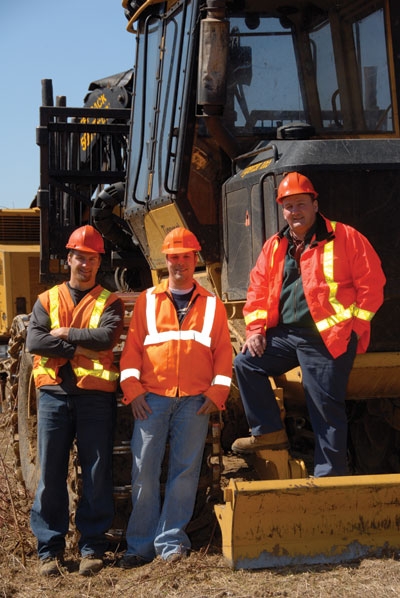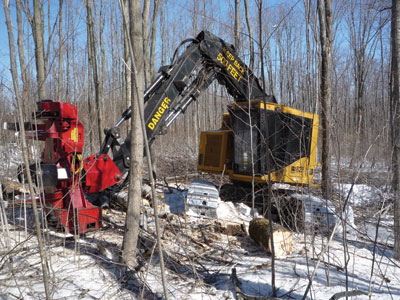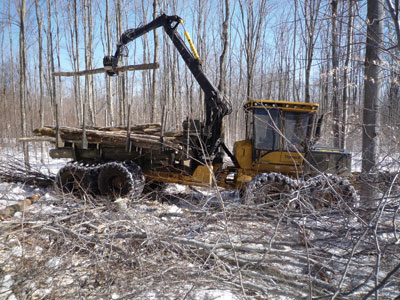
Features
Harvesting
Logging Profiles
Park Specialist
As Bob Robinson settles into his favourite booth at Pam’s Family Restaurant in downtown Maynooth, Ont., it feels like they should be playing the theme song from the ’80s and early ’90s TV show, Cheers – “Where Everybody Knows Your Name.” Robinson is obviously a fixture here at the eatery as owner Pam, and many of the locals having breakfast, take time to say hello, chat, and even throw a few friendly jabs at the local logger. He takes it all in his stride, giving each of them a few words back in return and teasing Pam, unjustifiably, about her cooking – she makes a mean plate of sausage and eggs and keeps your coffee cup filled to the brim.
November 14, 2011 By Bill Tice
 A Tigercat/Quadco combination works well for Robinson Logging when harvesting in Algonquin Park. Pictured with the equipment are (left to right): Brandon Robinson As Bob Robinson settles into his favourite booth at Pam’s Family Restaurant in downtown Maynooth
A Tigercat/Quadco combination works well for Robinson Logging when harvesting in Algonquin Park. Pictured with the equipment are (left to right): Brandon Robinson As Bob Robinson settles into his favourite booth at Pam’s Family Restaurant in downtown MaynoothRobinson has lived near Maynooth all his life and he makes no bones about loving the small-town life rural Ontario offers. He says living here has provided him with the opportunity to make a decent living, get to know his business associates and neighbours, and have family close by. He also says logging sustainably and in an esthetically pleasing manner is important to him, because as he notes, “I do live here and I want to know that the forests I harvest today will grow back and be here for my kids and my grandchildren.”
He knows the sustainability and reforestation aspect of the business well. Back at his house, which is about 10 minutes from town, he looks out the dining room window and points to a nearby hillside that is covered with a fairly mature forest. “That’s where I got my start,” he explains. “I logged that area in the late 1960s with my Dad when I dropped out of school. It was pulp wood and I had a chainsaw, one sharp axe and one dull axe,” he jokes, while adding that they used horses to pull the logs out.
Under the Microscope
Today, his logging business takes him a little further afield – mainly about 75 kilometres to the northwest in Algonquin Provincial Park where the logging practices and techniques of his company can on occasion be under the microscope, especially since they are one of the only contractors working in the park that uses mechanized harvesting.
Robinson says things have changed over the years and logging in the park can prove challenging. “It is very tightly controlled and we have to work within some extremely tight guidelines as set by the Algonquin Forestry Authority (AFA),” explains Robinson. “It used to be that they would ‘cherry pick’ when harvesting blocks in the park. Now it’s the opposite as we are taking out the defects and we are only doing selective harvesting where we thin out about 30% of the block.”
The AFA is a crown corporation and controls all harvesting and logging activities in the park. It is intricately involved in the harvesting process and writes prescriptions for the blocks that will be harvested. Sustainability is of course a key component in the AFA’s plans. Robinson says the AFA will categorize stems into “acceptable growing stock (AGS)” or “unacceptable growing stock (UGS).” However, he says it’s critical to strike a balance. “We don’t want to remove all of the UGS because some of these trees are needed for wildlife habitat, such as the squirrels, and the woodpeckers, and we want to leave most of the AGS for seed growing stock,” he says. “You can’t over harvest or you will lose your AGS to exposure or disease. It’s a tricky process, but right now we can see our next harvest already and it will be better quality than what we are harvesting today. Hardwood just has to be managed and harvested selectively because if you clear cut a hardwood forest you won’t get it back for 100 years.”
Robinson is no stranger to working within the confines of the park and has been selectively harvesting timber from the area since 1971 when he bought his first skidder – a Timberjack 217.
Over the next 17 years, Robinson mainly contracted for Martin Lumber on the southern tip of Algonquin Park near Harcourt, Ont., but did some work with the AFA as well, which included harvesting park wood that was being directed to nearby McRae Lumber in Whitney, Ont. Working with McRae, which is a lumber mill and chip producer, turned out to be a good move for Robinson as today they are his biggest customer. “The McRaes used to do their own logging on a forest licence and a bit in the park, but they ceased their logging operations around 2002 and we were able to pick up a lot of their logging work,” Robinson adds.
Contract Workforce
Until the late 1980s, Robinson continued to build his equipment arsenal, acquiring skidders, slashers, dozers and dump trucks. “We could basically handle stump to dump,” he says. That all changed in 1989 when Robinson Logging became a “management company,” selling much of the equipment to some of the loggers that worked for them. “We have found that managing works well for us,” he says. “The really good workers wanted their own piece of equipment and would contract to us anyway, and they were outperforming our own guys. They were being paid by volume and not by the hour and that was a better arrangement for everyone.”
Today, Robinson says they still do the road maintenance themselves as he notes this work is “spotty” in terms of the volume and he can’t expect a contractor to be there for just the times when he needs them. The road maintenance work includes keeping the haul roads in good shape with sanding in the winter and grading year round. Most of the work is done with a Champion 730 six-wheel drive grader, a John Deere 544 wheel loader and a Ford 9000 dump truck.
Robinson now has about 25 logging contractors working for him, including a number of members of the local Algonquin First Nation. Most of the contractors are doing hand felling and skidding. Three years ago, with a large amount of administration work needed to manage the contractors and the business, Robinson decided it was time to bring his son Brandon into the company on a full-time basis. Following a hockey career that saw Brandon play for Sudbury and Mississauga in the Ontario Hockey League and in Jacksonville, Fla., for a now defunct team in the Southern Professional Hockey League, he took a business program that helped him develop the management skills he needed to handle many of the day-to-day activities of the logging company.
The Mechanized Route
Son-in-law Dave Quehl, who grew up in the area and is married to Bob’s daughter Roanna, also plays a key role in Robinson Logging as a main contractor, and he completes most of Robinson’s mechanical harvesting in the park. “Right after high school I started doing some hand felling and skidding for Bob and then supervised on a few jobs for him,” says Quehl. “Then in 2003, we decided that we wanted to go a step forward and use bunchers in the park. There were a few out there already, but not many. Because we were working in Algonquin, we wanted to run the machine ourselves and have the control of the outcome. That’s when I branched out on my own and bought a Timberjack 608S with a Gilbertech head and contracted back to Bob’s company.”

In 2005, Quehl’s 608 was lost to a fire and he replaced it with a Tigercat 822 with a Tigercat hot saw. He replaced the head in 2007 with a Quadco 5660 processing head. He says they tried numerous grapple skidders on a rental or trial basis to find the right match for the conditions and the Tigercat/Quadco combination he was using for falling and processing. “Immediately after trying it, we settled on a Tigercat 1065 forwarder and that is the combination we are still using today.”

About three quarters of what Robinson harvests in the park goes to nearby McRae Lumber. It’s a tree length mill so Quehl says they cut most logs to about 24 feet in length, which he says is essentially a tree length log. “It’s not quite cut to length, but it is close, which makes it easy to handle, and this way the mill can make the merch decision rather than me,” he explains. “This means they can give the customer what they want from inventory and don’t have to pass the specifications on to me. For example, if the customer wants eight-foot and 16-foot lengths, they can use what they have in the yard and don’t have a bunch of 12 footers sitting there that can’t be used.”
For Robinson Logging, having Quehl harvest mechanically offers some major advantages. “We have a longer season, we can work in adverse weather conditions, it’s safer, and we can work toward the lighter footprint the minister wants to see in Algonquin Park,” says Bob.
AFA Review

Park administrators also see the advantages of mechanized logging and Bill Hubbert, area manager for the AFA, says they are very pleased with the results Robinson Logging has achieved to date. “We’re facing the same issues as other people in the forest industry as far as workforce and trying to get young people into the game, so we can accomplish more with mechanized harvesting,” he says. “ That is just one of the drivers in moving towards more mechanized operations. Another is the environmental aspect, especially when you are working in a park. You have to consider things like ground pressure and damage to residual trees and as we move into the future we will have to look at how bigger pieces of equipment can cost effectively get the job done. Bob has tried various things over the years and the system he uses now seems to shine above equipment combinations he and other loggers have used in the past. This is the first system we have seen that is totally mechanical using two pieces of equipment in hardwood selection, including handling the tops. It can operate in most weather conditions, it minimizes site damage, and we don’t have to have a guy on the ground with a chainsaw. We have lots of people in the park that do excellent work, and this system ranks with our top conventional crews. Dave is also an excellent operator and if you are going to experiment with this, they are good people to have. Bob harvests about 100,000 cubic metres every year for us and about a quarter of that is with this equipment. We are pretty excited to see it in the park.”
When working in the park, Quehl says he likes to start at the block boundary and will normally build a main trail diagonally across the block, depending on the terrain. The Tigercat/Quadco combination can reach up to 27 feet so he will process one side, then turn around and come back the other way. About every 30 metres, he will create a side trail or spur. He processes on the trails and then brings the wood to the main trail for the forwarder, which is typically one day behind him. The forwarder has an 18-tonne capacity and can bring about 16 cubic metres per trip out to the road, where two contract loaders work to load up the log trucks. The forwarder will do 15 to 20 cycles per day.
Looking forward, Bob says he would like to see his company do more mechanized harvesting. Like Algonquin Park’s Hubbert, he says recruiting and keeping people is a challenge. “Our workforce is getting older so I would like to see more of them move to mechanized,” he says. “It’s not going to be easy. They need training because you can’t just jump from a chainsaw to a mechanized harvester, but I think with mechanized you have less people producing more volume with less problems. We
really need to keep people cutting wood and I won’t be content until we are doing more of it mechanically.”
Print this page